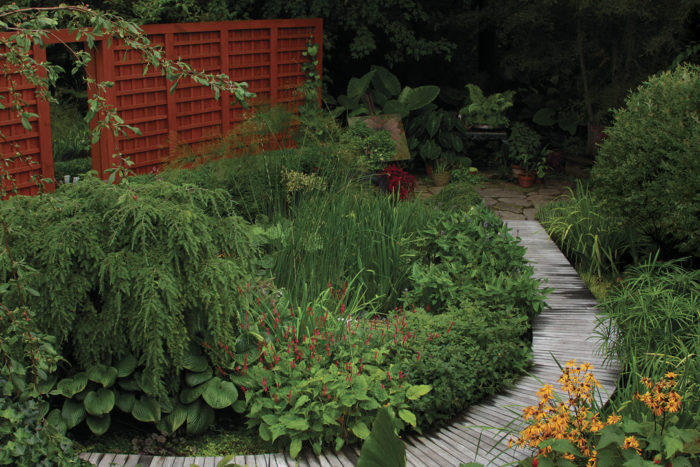
One thing that gardening teaches you is the ability to see potential in all that surrounds you. This was something I had to learn the hard way when my husband and I purchased our home along the shore of Lake Michigan, because the property had been badly neglected for 10 years. Through the process of clearing the land, we discovered a beautiful stone wall built into a large hill, at the base of which was a mucky, wet depression (30 feet long and wide). Because I had learned to take the good along with the bad with this property, I started thinking of a way to work with the low-lying depression, instead of calling in the dump trucks and French-drain experts to dry out the spot. That’s when I decided not to fight nature but to embrace it by creating a bog garden.
Walls make the spot a destination
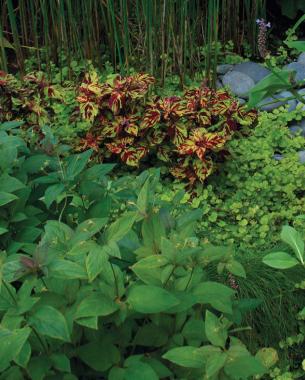
Many gardeners out there have faced the same challenge that I faced with my mucky spot. You may not have a large stone wall to work with but a shallow depression in the yard or a dip at the bottom of an elevated spot. Any place where water does not have a proper channel in which to flow and drain can become a muddy, soft spot and, in turn, a delightful bog garden. But the first step to take before filling the space with plants is to build a wall or two to make the spot a destination.
Walls in a garden clearly define a particular space. They can simultaneously create a sense of mystery and privacy. But they are exceptionally important in a bog garden because they make you ask, “What’s over there?” instead of saying, “What’s that muddy spot?” A wall is also a four-season focal point, which is essential because not many evergreens tolerate wet feet, with the exception of hemlock (Tsuga spp. and cvs., USDA Hardiness Zones 3–9). Walls also create microclimates by blocking winter winds and by reflecting and holding in heat. This enables you to use plants in your bog garden that ordinarily might not be hardy in your zone.
Our watery area backs up to our property line, so for us, a bold, contemporary wall seemed like a great way to gain some intimacy while also giving the space more interest and definition. To soften the edges and overall appearance of the rust-colored wall, I planted Dutchman’s pipe (Aristolochia macrophylla, Zones 5–8) at its base and let it take over. This particular ornamental vine actually prefers wet conditions. The wall turned out to be the first bog-garden project for my husband, Ron. But another soon followed.
But what about …
Still not convinced that a bog garden is the answer to your muddy-spot woes? Here are some common concerns and practical answers that may help you decide if this is the right type of garden for you.
The smell: It’s true that a combination of mud and standing water can create an unappealing aroma. The root systems of plants help soak up the excess water, filtering it at the same time, which cuts down on the stinkiness. I also incorporate fragrant plants around the borders of the bog where soil conditions are a bit drier. We have, for instance, a huge mock orange (Philadelphus coronarius, Zones 4–9) that cascades over our lattice wall and perfumes the air during the wet spring season.
The bugs: Mosquitoes and gnats can be an issue, but I do a fairly good job of controlling them using natural products, like pond dunks and Bt (Bacillus thuringiensis). You can also encourage natural predators, like bats, to move in and keep the bugs in check.
The house: There are certainly wet, poorly drained areas that should not be converted into a bog garden. If your mucky area is close to your house and has the potential of threatening the foundation, you need a drainage system, not a garden. If the wet area is too wet—that is, if every time it rains the end of your driveway washes out and turns into an 8-foot-deep lake—then you need professional landscape help, not a bog garden.
A way in and out is crucial
The next dilemma (and project for my husband) was figuring out how to get in and out of the bog without losing our shoes to the mud. We constructed an elevated walkway out of ipé, a tropical hardwood that is five times harder—and, therefore, more weather resistant—than cedar or redwood. It seemed like the perfect choice to withstand the humid conditions of the bog.
The walkway curves to give the space more definition and to provide more of a journey for those walking through. It wouldn’t make sense to have a walkway to nowhere, so we built a flagstone patio at the end of the path—and in a drier location just beyond the bog—so that we’d have a spot to sit and enjoy the unique surroundings. The walkway serves as a boardwalk of sorts. It allows you to look down and around at all of the plants without having to experience the muddiness up close and personal. And the walkway served one more important function: It provided me with an easier way to plant the area.
Plants serve multiple functions
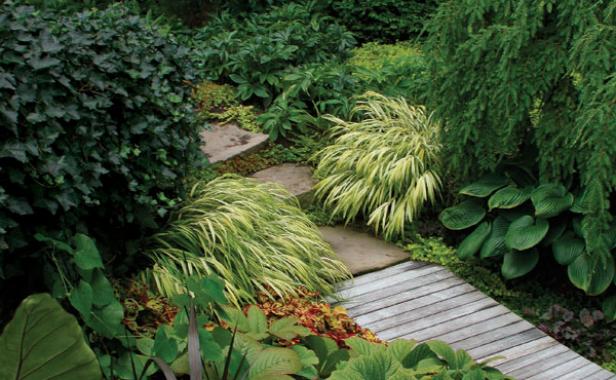
Once the bones of the garden were complete, the final step—planting—began. Even the most experienced gardeners might think that the selection of plants that like wet feet is, at best, limited. But fear not. I discovered an enormous plant list from which to choose, even for my cool zone.
Large, bold plants with strong forms are best because they tend to have expansive root systems that help soak up and filter out standing water to cut down on the potential stagnant smell. I looked first to several midwestern-native swamp plants, including white skunk cabbage (Lysichiton camtschatcensis, Zones 5–9). Its subtle hoodlike blooms in spring are followed by leaves that reach an impressive 40 inches long. Siberian iris (Iris ibirica and cvs., Zones 3–9) is an old standby, which forms striking clumps of vertical foliage. The colorful blooms—in different shades of purple, yellow, and white—are magnificent in late spring, as well.
My favorite bog plant is Chilean gunnera (Gunnera tinctoria, Zones 7–11). Although not destined for my climate, it’s happy tucked up against the stone wall of the bog garden, and it gets heavily mulched in winter. Some winters, it suffers more than others and is slow to emerge and size up the following year, but it has reliably come back for several seasons. Many other tropical plants do well in boggy, wet areas as well. Although not hardy in Michigan, I still love them. Elephant’s ears (Alocasia spp. and cvs. and Colocasia spp. and cvs., Zones 9–11) provide bold forms and a splash of color to the space. I overwinter them as houseplants and put them back into the garden each spring. I filled the spaces between these large plants with an array of other perennials and shrubs that tolerate wet conditions.
For anyone who has inherited a property with a muddy, seemingly inhospitable area, I can truly sympathize. But with a clear plan and a little creativity, you might find that it will end up being your favorite spot instead of a dreaded eyesore.

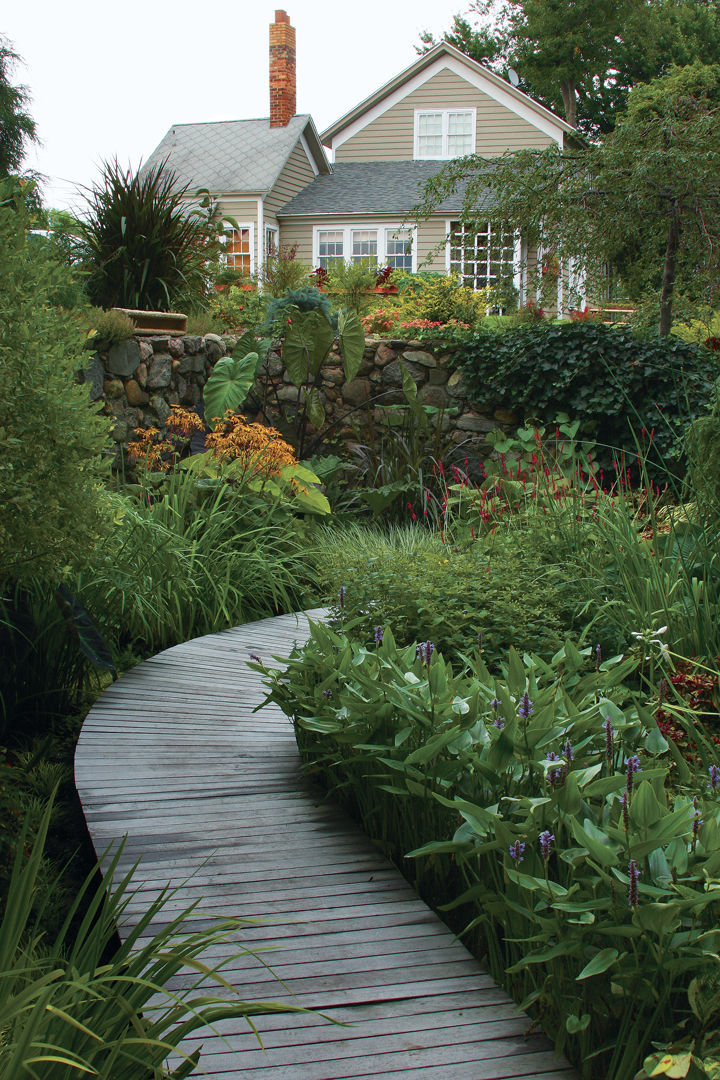

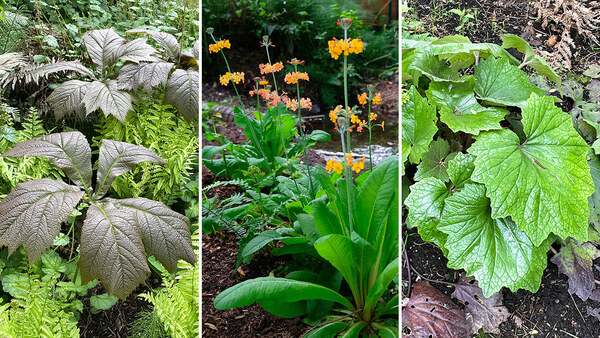
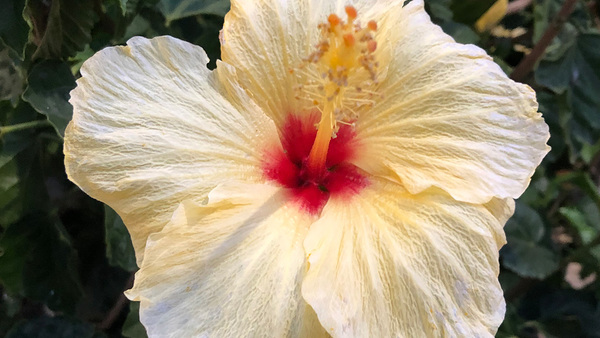













Comments
Talk about making lemonade out of lemons... this is so nice. Looks natural. Well done. I remember my parent's yard having a low point in the backyard. Dad was insistent on keeping a lawn there which didn't work. Your method would have been so much nicer.
Log in or create an account to post a comment.
Sign up Log in